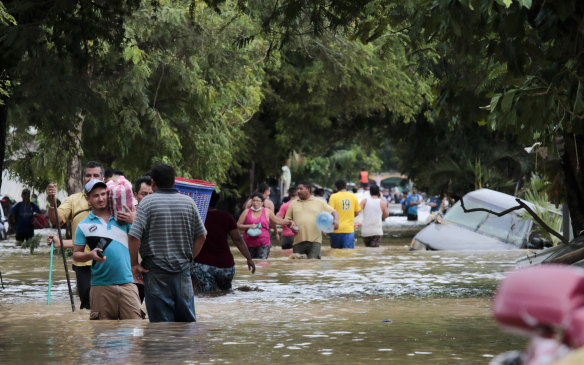This was published 4 years ago
Cuba, Florida brace for storm Eta after deadly toll in Central America
Havana: Cuba's meteorology office warned on Saturday of torrential rain and flooding as Tropical Depression Eta churned northwards towards the Caribbean island, and on track to Florida, after killing more than 70 people in Central America last week.
Eta could strengthen back into a tropical storm over the warm Caribbean waters before making landfall on the southern coast of central Cuba overnight, the office said, warning of coastal flooding and winds of up to 100km/h.

Residents in Honduras wade through floodwaters, past inundated vehicles.Credit:
Flooding could be a problem more broadly, it said, given Cuba was already waterlogged in the wake of heavy rains of late and Eta could potentially dump more than 30cm of water on central and mountainous regions.
"As the ground is already saturated, any additional rain could provoke inundations especially in mountainous areas and along the rivers," Cuba's meteorologist Jose Rubiera said on state-run TV.
The northwestern coast, including Havana's seafront, will probably flood moderately from Sunday to Tuesday, he said.
The government - well known for preparedness in the face of natural disasters - discussed measures on Friday to evacuate people, especially those living downstream from dams, and protect crops, homes and animals, according to state-run media.
Given Eta's stormfront was uneven, there was the risk of torrential rain occurring across the entire country and Prime Minister Manuel Marrero warned against complacency in eastern or western regions.
The US National Hurricane Centre (NHC) warned that flash and urban flooding would also be a possibility for the Cayman Islands, Jamaica, the Bahamas and southern Florida.
Tropical storm conditions were possible in the Florida Keys and south and central Florida from late Sunday, it said.
One of the fiercest storms to hit Central America in years, Eta struck Nicaragua as a Category 4 hurricane on Tuesday with winds of 241km/h before weakening to a tropical depression as it moved inland and into neighboring Honduras and Belize.
Across swathes of the mostly poor countries wedged between Mexico and Colombia, high winds, torrential rains and catastrophic flooding caused deadly mudslides and damaged hundreds of homes.
Reuters